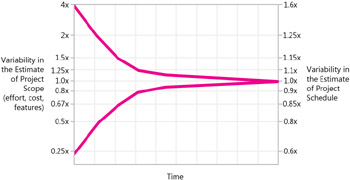20.1 The Basic Schedule Equation
20.1 The Basic Schedule Equation
A rule of thumb is that you can estimate schedule early in a project using the Basic Schedule Equation:
| (#17) |
In case your math is a little rusty, the 1/3 exponent in the equation works the same as taking the cube root of StaffMonths.
Sometimes the 3.0 is a 2.0, 2.5, 3.5, 4.0 or similar number, but the basic idea that schedule is a cube-root function of effort is almost universally accepted by estimation experts. (The specific number is one that can be derived through calibration with your organization's historical data.) Barry Boehm commented in 1981 that this formula was one of the most replicated results in software engineering (Boehm 1981). Additional analysis over the past few decades has continued to affirm the validity of the schedule equation (Boehm 2000, Stutzke 2005).
To use the equation, suppose you've estimated that you will need 80 staff months to build your project. The schedule computed from this formula ranges from 8.6 to 17.2 months depending on what coefficient from 2.0 to 4.0 is used. The nominal schedule will be (3.0 x 801/3), which is 12.9 months. (I don't recommend presenting the schedule estimate with this much precision; I'm including it here to make the calculations easier to follow.)
| Tip #89 | Use the Basic Schedule Equation to estimate schedule early in medium-to-large projects. |
The schedule equation has some interesting implications for the Cone of Uncertainty, as shown by the numbers on the right axis of Figure 20-1.

Figure 20-1: The Cone of Uncertainty, including schedule adjustment numbers on the right axis. The schedule variability is much lower than the scope variability because schedule is a cube-root function of scope.
The schedule equation is the reason that the uncertainty ranges in Figure 20-1 are much broader for efforts than they are for schedules. Effort increases in proportion to scope, whereas schedule increases in proportion to the cube root of effort.
The schedule equation implicitly assumes that you're able to adjust the team size to suit the size implied by the equation. If your team size is fixed, the schedule won't vary in proportion to the cube root of the scope; it will vary more widely based on your team-size constraints. Section 20.7, "Schedule Estimation and Staffing Constraints," will discuss this issue in more detail.
The Basic Schedule Equation is also not intended for estimation of small projects or late phases of larger projects. You should switch to some other technique when you know the names of the specific people working on the project.
EAN: 2147483647
Pages: 212